Looking for your next adventure? It starts here!
Join our women's adventure community for exclusive trips, partner benefits and inspirational articles delivered straight to your inbox.
For women who want to collect experiences, not things.
Book a TripOur Larger Trips
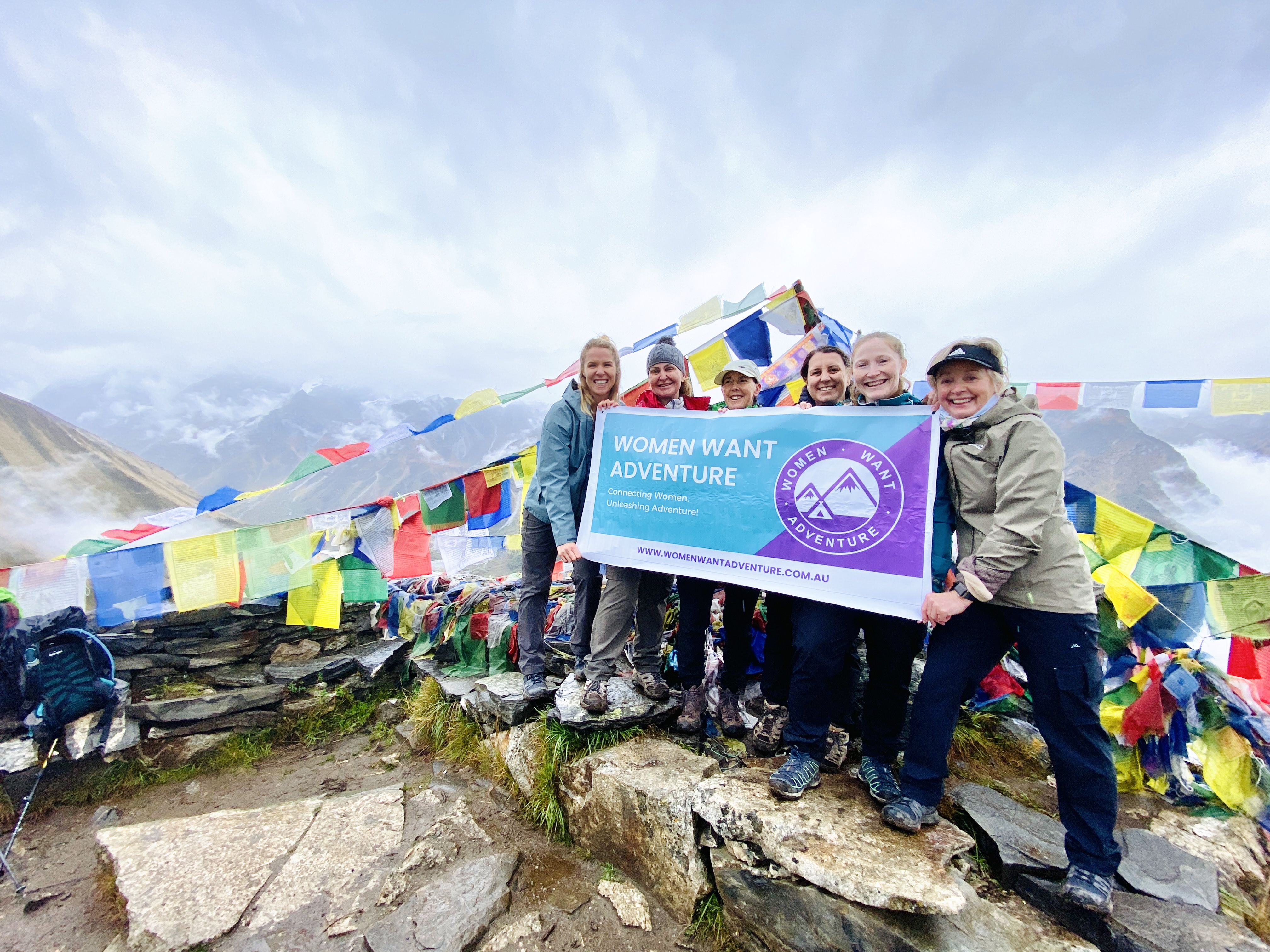
Bordering Tibet, the high and isolated Langtang Valley lies between the main Himalayan range of the north and a slightly lower range of snowy peaks to the south. Due to its close proximity to Tibet, Langtang Valley is one of the best treks to meet the welcoming Tamang people, whose religious practices, language and dress are more similar to those of Tibetans than to the traditions of their cousins in the middle mountains.
Langtang is the closest trekking destination from Kathmandu. The trek is surprisingly quieter than regions of Everest and elsewhere on the Annapurna massif, providing a less-travelled, more intimate trekking experience with an abundance of wildlife, majestic waterfalls, and 360-degree views of the Himalayan mountain range from Annapurna in the West to Makalu in the East.
The captivating Langtang Valley trek follows the river upstream through forest of pine, bamboo, rhododendron and pastures to arrive at the alpine meadows of Kyanjin Gompa, where exceptional views of soaring, snow-capped peaks and glaciers await the adventurous.
During your trek, you’ll enjoy views of the highest summits in the area, including Langtang Lirung (7,246m) along with Gang Chhenpo (6,388m) and Naya Kanga (5,846m) and the breathtaking Dorje Lhakpa (6,966m).
Your trekking adventure starts with a walk up the Langtang Valley to Langtang Village (3,430m) in Langtang National Park. This allows gradual acclimation to the altitude and a chance to admire Nepal's natural flower, the rhododendron, in bloom.
As you trek, you'll wander under prayer flags and across suspension bridges, experiencing highlights like crossing the Bhote Koshi river, visiting Buddhist monasteries, yak pastures, and a renowned cheese factory. Evenings in the village bring cozy stays in traditional tea houses, offering meals made with fresh, local ingredients.
The journey ascends to the valley's upper reaches, where yaks roam and peaks rise, offering breathtaking views towards Tibet. A major highlight is climbing to Kinjii Rii Peak (4,300m) for a stunning sunrise view of the Langtang Range, and exploring the Langtang glacier and the yak pastures of Langshisha Kharka.
The trail, alive with locals, mules, and wildlife, lets you witness traditional lifestyles, like wood carrying, bamboo weaving, and farming. The rich biodiversity includes oak, fir, pine, maple, hemlock, black bear, rhesus monkeys, Himalayan tahr, red pandas, pika, musk deer, lophophorus, and various birds.
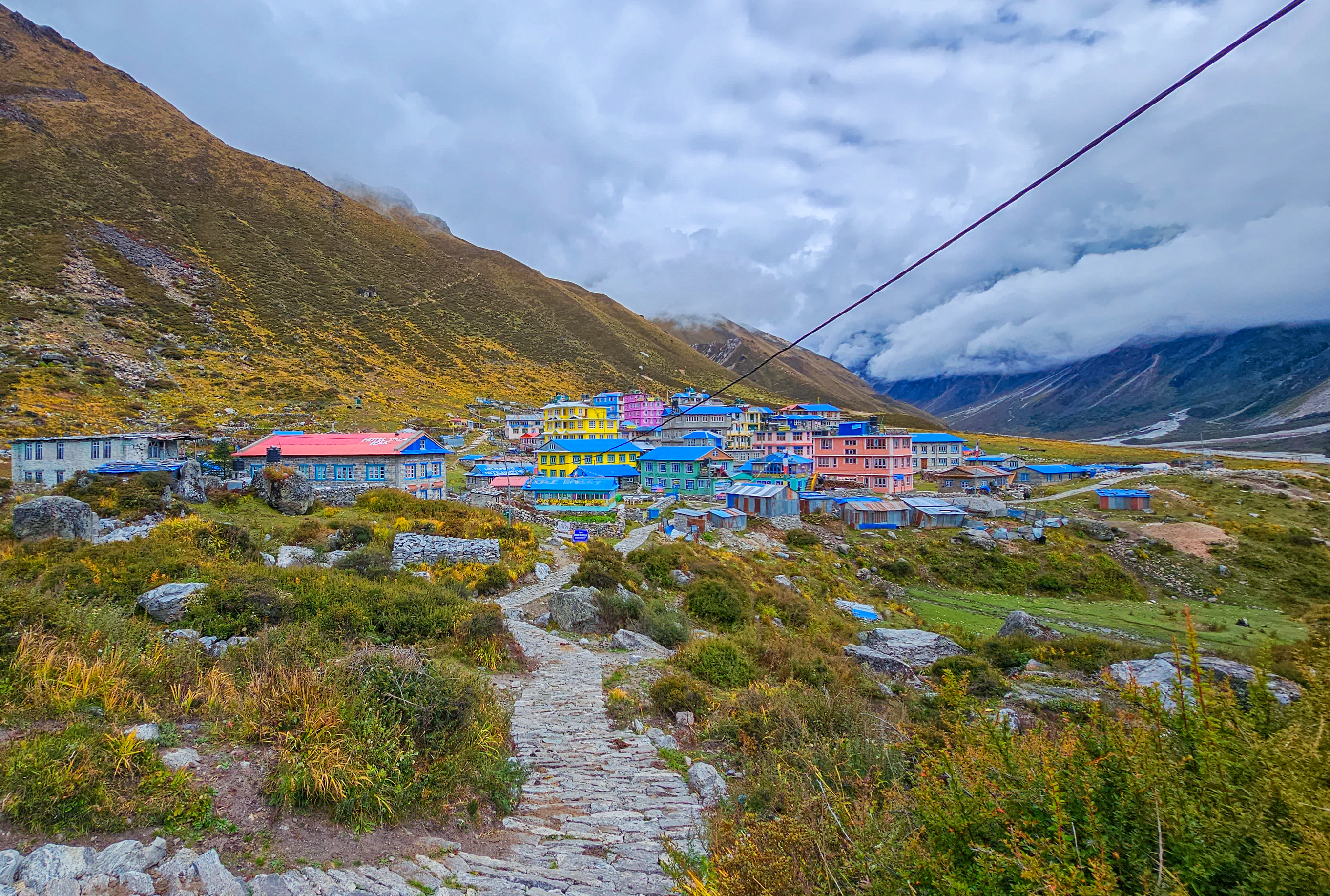
* All prices are per person and listed in Australian Dollars (AUD). All prices shown are GST inclusive where applicable.
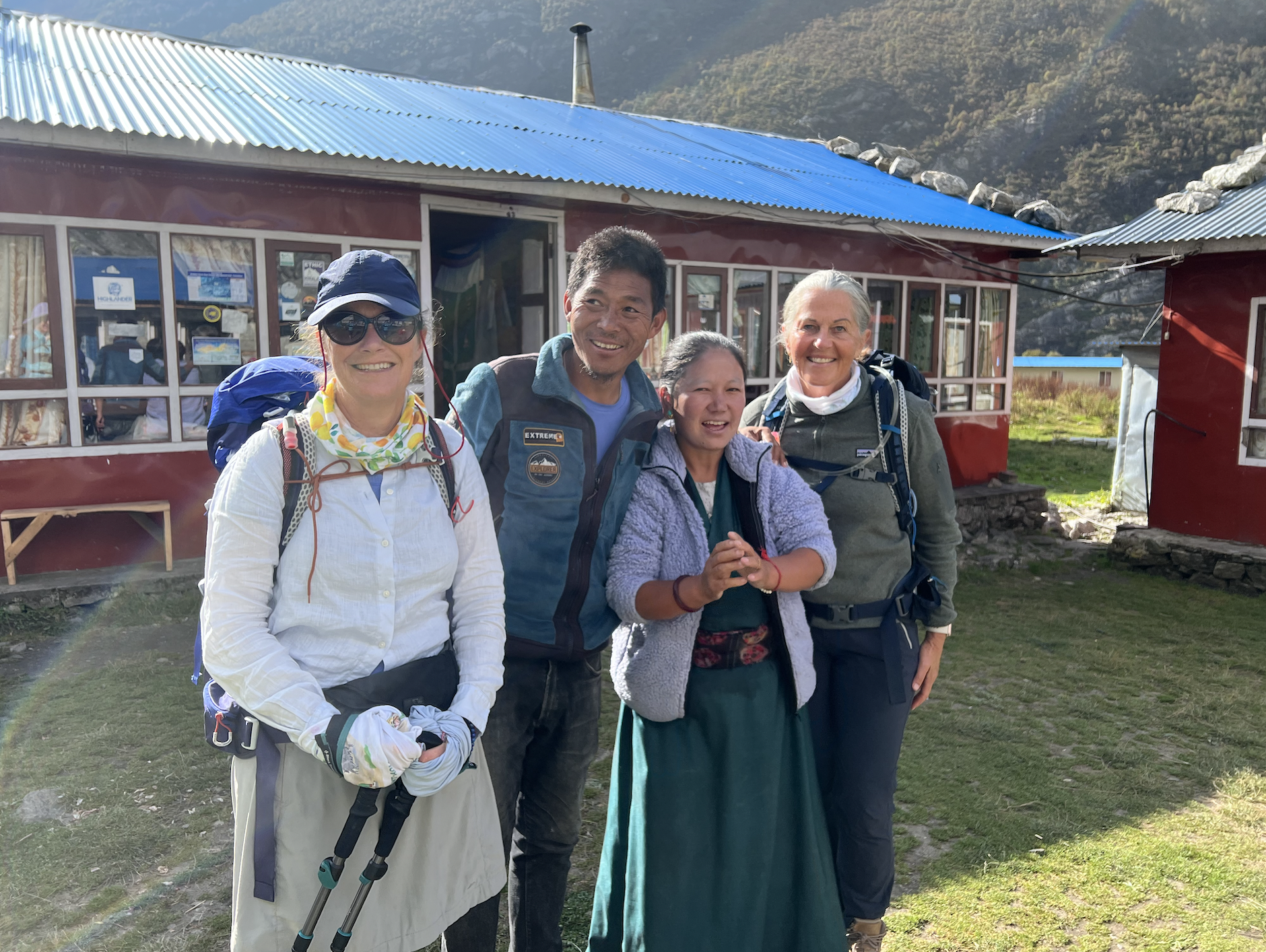
Upon your arrival at Tribhuvan International Airport, you'll be greeted by one of our friendly team members – often it's Mango (wait until you see how charming he is!). He'll escort you to The Kathmandu Guest House in Thamel in the comfort of a private vehicle. Don't worry if your flight lands late at night; we'll be there to welcome you, no matter the hour. The drive to the hotel is typically around 35 minutes, depending on traffic.
Once at the hotel, you’ll find the check-in process a breeze. Settle into your private room and let the weariness of your flight dissolve into the coziness and comfort awaiting you.
For important details on visas and helpful tips for your flight arrival, please refer to the essential information we've provided.

Kathmandu is a wonderful mix of the ancient alongside the modern. Crowded, busy streets, cars, motorbikes, and buses thread their way between ancient temples, crumbling shrines and modern offices, as picturesque palaces slowly sag into dereliction and Buddhist stupas gaze over the bustling scene with their all-seeing eyes. Although a crowded, noisy, and polluted city, it is also friendly, fascinating and vibrant.
Today is free time for you to explore and enjoy sight-seeing in your own time. Join up with other women on the trip, or enjoy experiencing these sites individually.
If you’re looking to get the most from your time here, we recommend the following:
Pashupatinath – The largest Hindu Temple of Nepal, dedicated to the supreme Hindu God, Shiva, situated on the banks of the Bagmati River. At Pashupatinath, you’ll see exceptionally carved statues and idols of Hindu deities, as well as a long row of Shiva-Lingas. This complex of small temples – and the golden hood at the top of the main Temple – are truly fascinating. Moreover, you’ll get the opportunity to witness a Hindu death ritual at Pashupati Aryaghat – a unique cultural experience that will linger long in your memory.
Boudhanath – A site that holds huge religious significance among the Tibetan Buddhists of Nepal. A major shrine on the ancient Indo-China trade route, traders and scholars would visit Boudhanath seeking blessings for a safe journey through the high Himalayan passes to Tibet. Even today, saffron-robed monks practice daily circumambulations of Boudhanath, as colourful prayer flags touch the skyline from the dome pinnacle to the base of the large monument. The centre of Tibetan culture in Nepal, Boudhanath is a truly special place.
Durbar Square – Located before the old royal palace of the former Kathmandu Kingdom, the exemplary wooden and stone craftsmanship of this site makes it a prominent attraction. Stone-paved streets and pagoda-style religious monuments displaying different Hindu deities reveal the cultural delights and exquisite craftsmanship of ancient and medieval Nepal at Kathmandu Durbar Square.
Swayambhunath – High atop a hill in the Kathmandu Valley, the ancient religious complex of Swayambhunath is home to a stupa and various temples honouring the ‘Self-Created’ nature of the valley, over which the painted eyes of the Buddha maintain an eternal watch. As one of the oldest religious sites in Nepal and the second-most sacred site in Tibetan Buddhism after Boudhanath, you’ll get to experience an authentic taste of one of the world’s greatest, most beautiful faiths here at Swayambhunath.
In the evening, we’ll meet as a group at Kathmandu Guest House at 4pm or our pre-trek briefing. The briefing will be approximately 1hr in in duration.
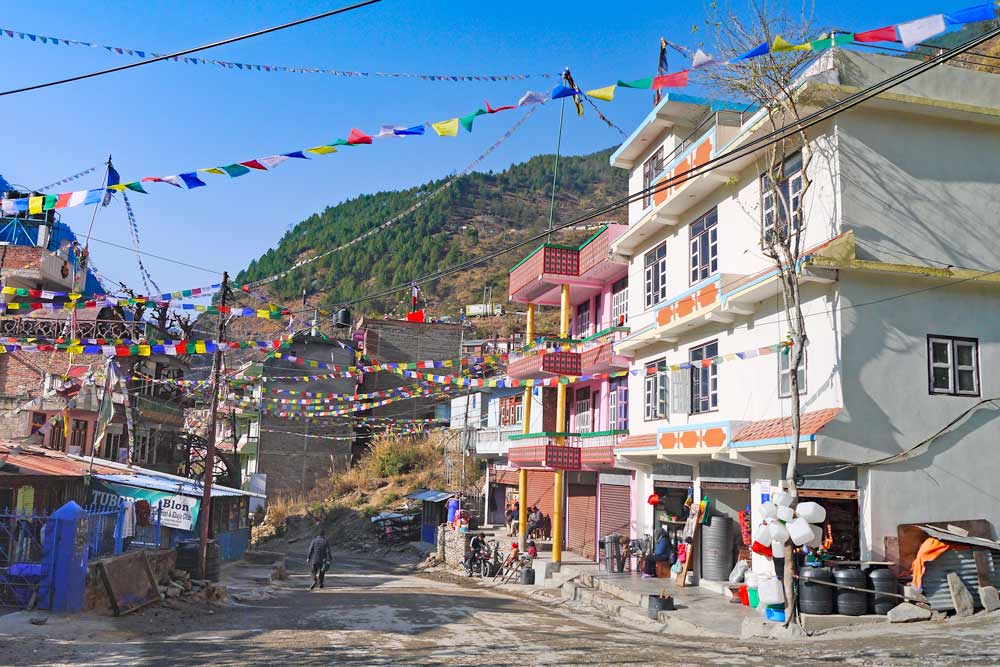
After an early breakfast we’ll drive north in private vehicles from Kathmandu to Syabrubesi, a small village on the banks of the Bhote Kosh river that forms the trek’s starting point to Langtang Valley – about 7-8 hours’ drive (pending road conditions). Enjoy the scenic drive through Trishuli Valley with rural villages, rivers, and mountains along the way. Parts of the road are unsealed and the condition of the road and time travelling often depends upon the monsoon season. While the group will stop at one of the restaurants on the way for lunch, it's a good idea to pack snacks with you for the drive along with charging your headphones/Kindle. We will reach Syabrubesi (1,420m) around 2 or 3 o'clock, after which we’ll take time to explore and settle into our tea house accommodation for the night.
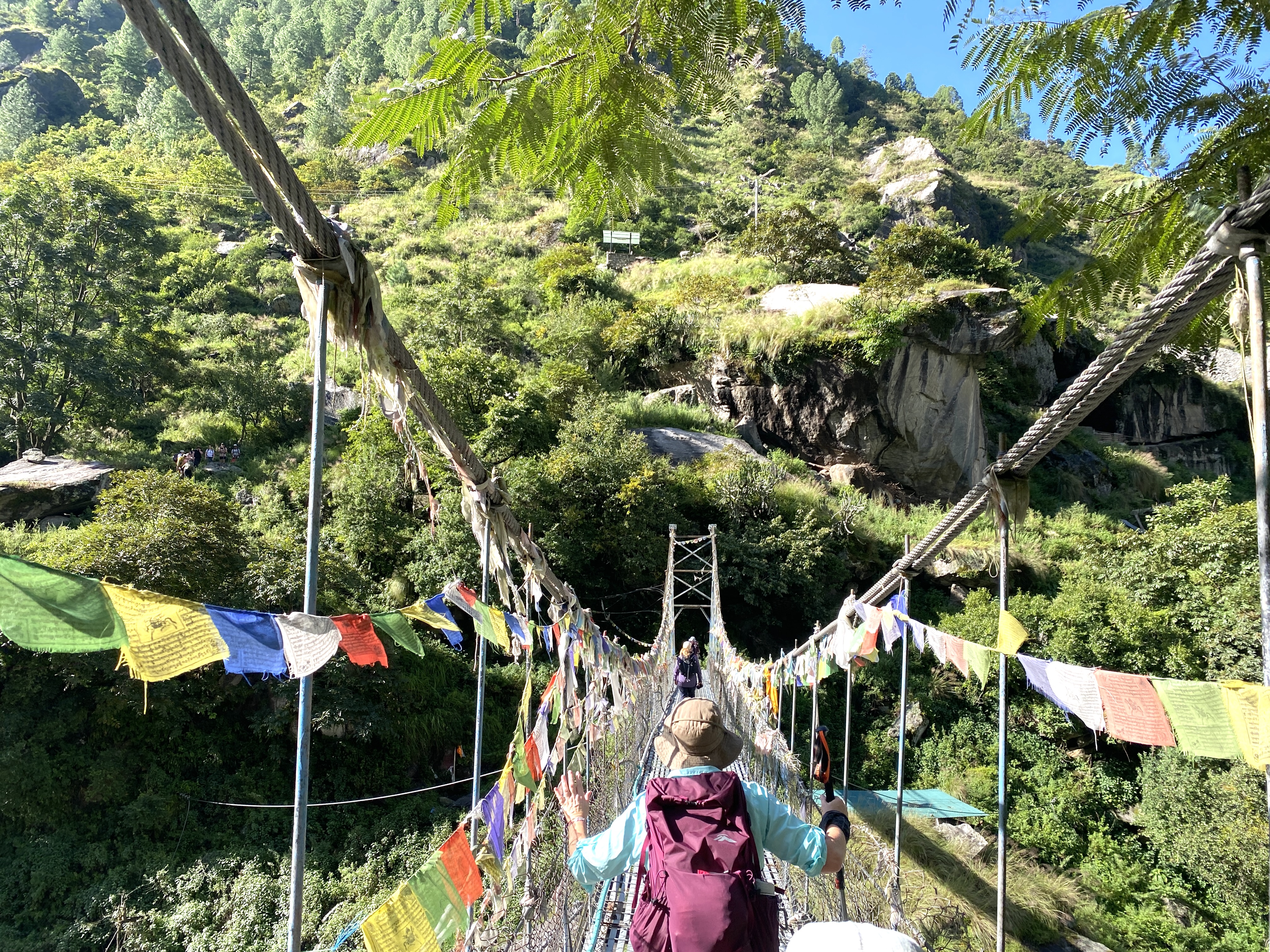
The first day of trekking is one of the harder and longer days at 17.5km. This is when we start gaining elevation while your legs are still fresh. We wake up early for breakfast and aim to leave by 7 am. From our tea house at Syabrubesi, we’ll begin our trek to Lama Hotel. It’s really important you have your hiking poles with you and plenty of snacks on hand.
The trail crosses the Bhote Khola via a suspension bridge before continuing east, following the fire trail upstream along the Langtang Khola. The trail begins with a moderate climb, zigzagging up the broad valley as we enter the forest. During your ascent, you'll see the village of Thulo Syabru clinging to the high valley side. Shortly after this, you’ll join the trail leading to and from Thulo Syabru, before entering a deep gorge which marks the start of the Langtang Valley.
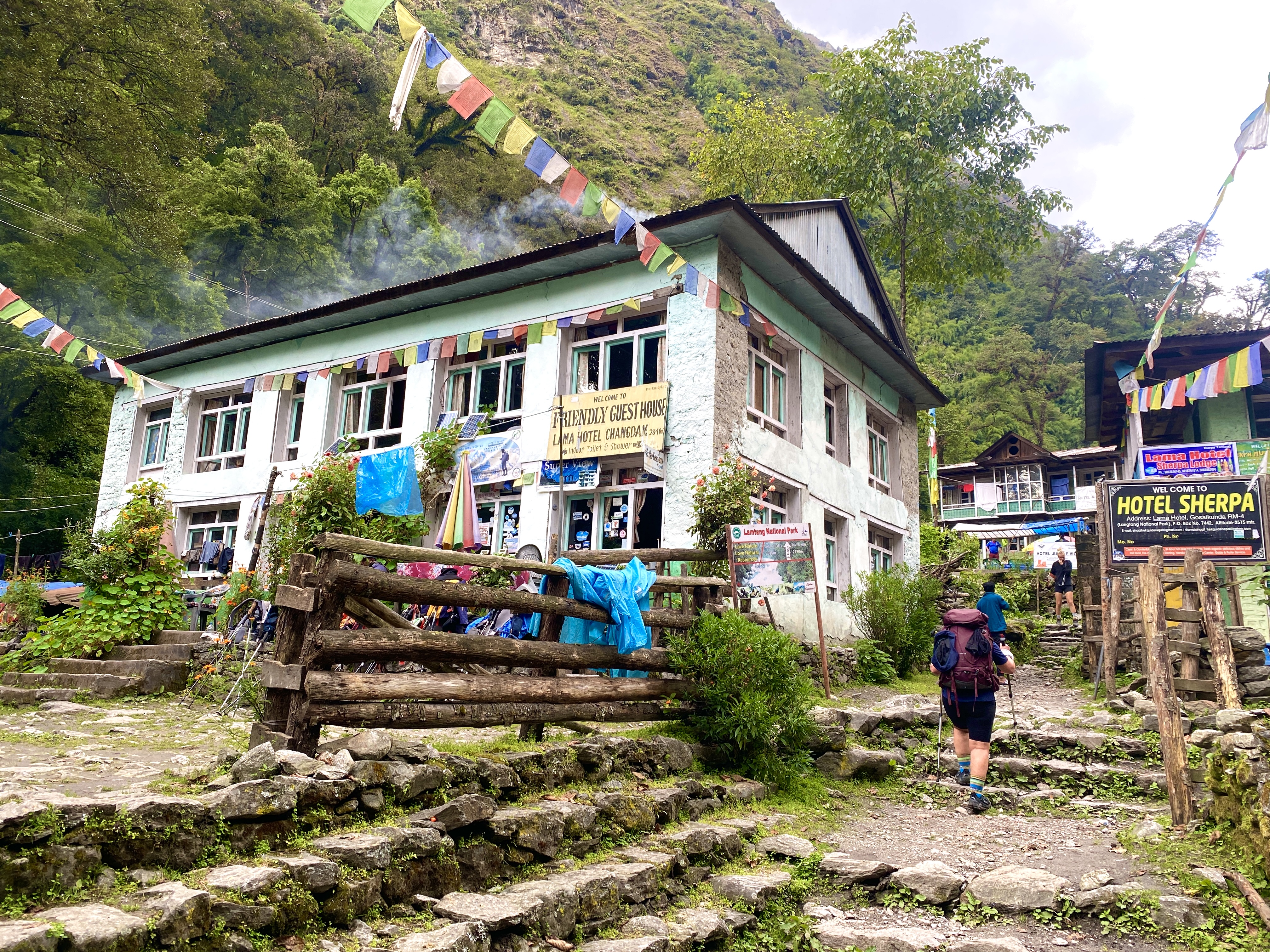
From here, you’ll begin a steady, 2-hour descent through a bamboo forest to the valley floor where the small village of Bamboo (1,850m) awaits. On the trail, we’ll have many opportunities to view well-established villages, as the trek climbs gently up to Rimche (2,400m) on the banks of Langtang Khola. Finally, we ascend through a dense bamboo forest to arrive at the Lama Hotel (2,500m). If we're lucky, we may spot wildlife such as red pandas, monkeys, and bears today, so have your cameras ready!
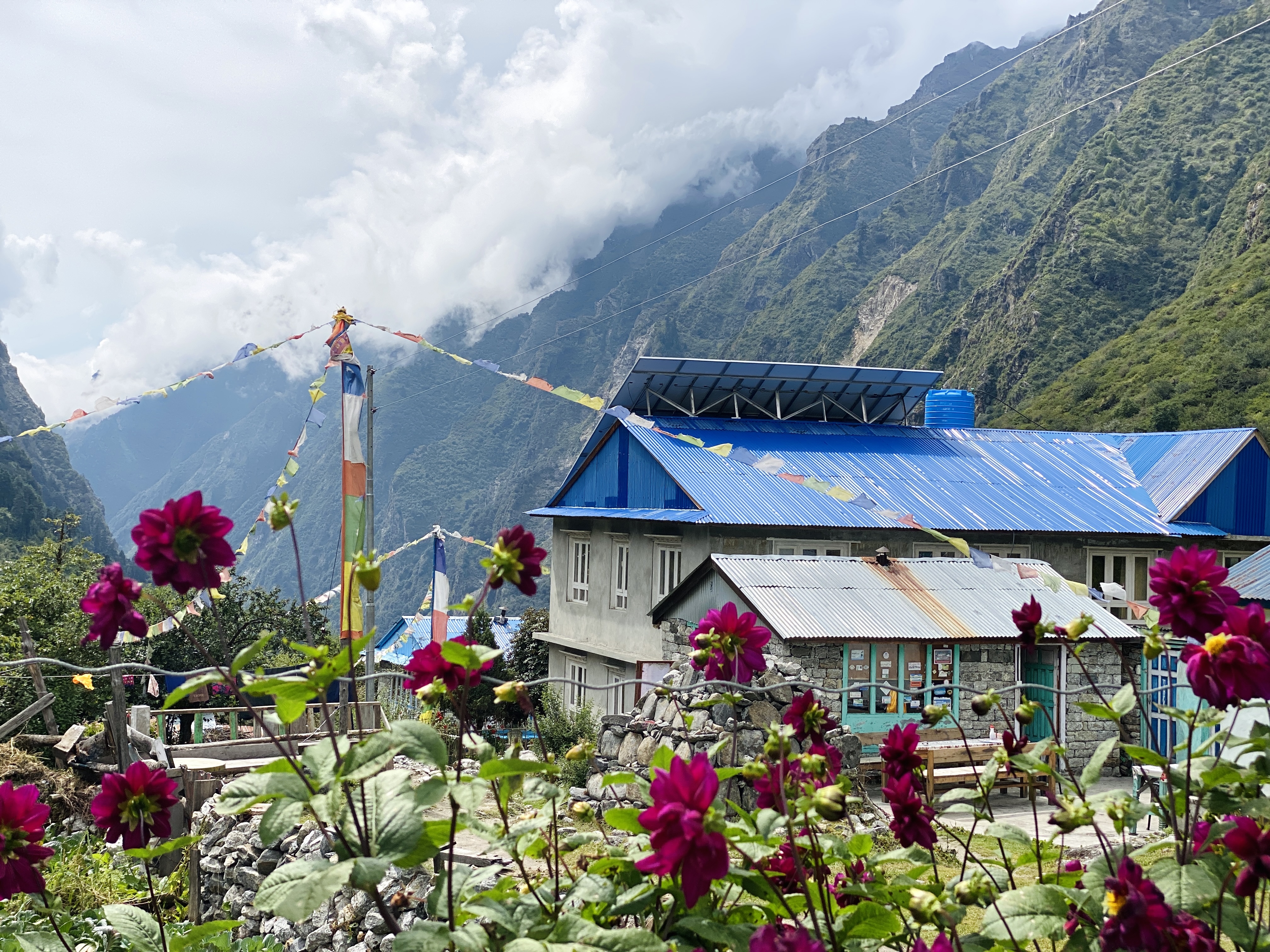
Langtang Village is like a Nepalese surprise package! There's an amazing bakery – details to be revealed later. WiFi and hot showers? It's a bit of a lucky draw – sometimes you hit the jackpot, sometimes not. In Nepal, expect a mix of this and that – it's all part of the adventure! So, come ready for anything and embrace the unexpected.
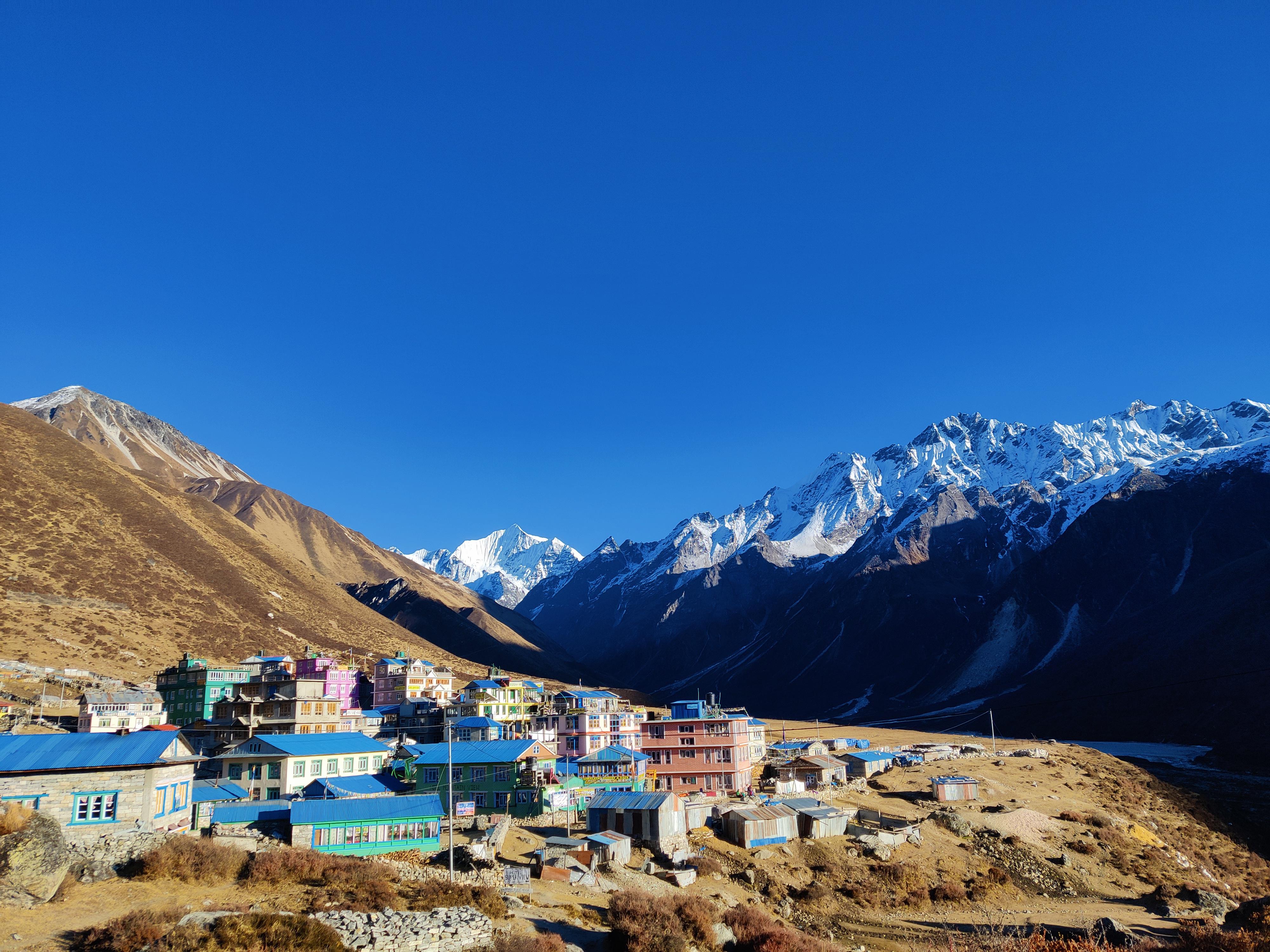
After a leisurely breakfast at 8 am (yay for a later start on a shorter trekking day of about 3 hours of hiking), we’re back on the trail by 9 am. We'll climb gradually through quaint villages and serene yak pastures, as the valley unfurls and the views become increasingly spectacular. The mountain peaks start to make a grand appearance on either side of the valley – it's breathtakingly beautiful! We stop for a cup of tea after approximately 1.5 hours (bring your snacks).
As we cross several small streams and moraines, we'll reach Kyangjin Gompa – the pinnacle of our trek at an impressive altitude of 3,870m above sea level. Here, the views of Mt. Ganchempo and Mt. Langtang Lirung are nothing short of sublime. We’ll also take a peek at the quaint monastery and the government-operated cheese factory (yes, you heard that right, Yak cheese at this altitude!). Please reminder to tip if entering the Cheese Factory and monastery. We’re aiming to arrive at Kyangjin by lunchtime, giving us ample opportunity to acclimatize and explore this dramatic setting, encircled by snow-covered peaks in every direction. Plues the panoramic views of Dorje Lhakpa (6,990m), Langtang Ri (6,370m), and Langtang Lirung (7,245m) are simply jaw-dropping.
Our top tip for the afternoon? Take it easy and relax. Let your body adjust to the altitude so you're ready to ascend to even higher peaks the following day. It's the perfect excuse to kick back and soak in the scenery!
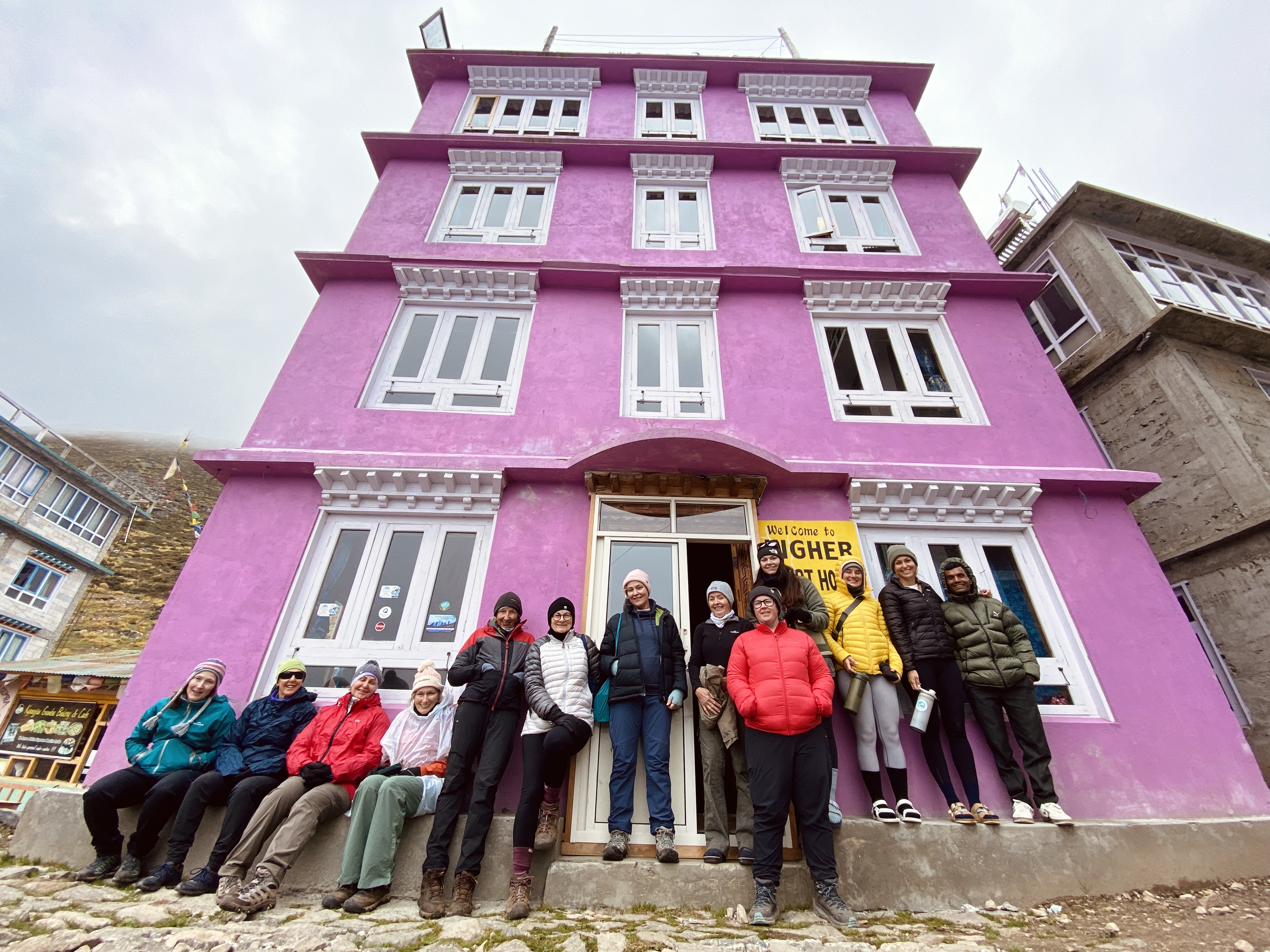
The Higher Guest House offers a delightful perk – hot showers! Usually, fingers crossed. And guess what? There's WiFi too (quite the rare gem in these parts!). But here's a friendly nudge: how about taking a little break from the digital buzz? Instead, take the opportunity to chat with the tea house owner. He's a treasure trove of stories, especially about the 2015 earthquake and the recovery of the villages in this region. It's a chance to connect with local history and culture firsthand.

Today, we embark on a remarkable journey to Kinji Ri peak, standing proud at 4300m. The day begins early, around 6.30-7 am, to catch the sublime sunrise casting its glow on the snowcapped mountains – a serene moment that’s well worth the early start. The weather at this altitude is more favorable in the morning, and your guides will confirm the exact departure time the evening before.
The ascent to Kinji Ri is challenging yet immensely rewarding, featuring a steep path interspersed with loose rocks. We highly recommend using your hiking poles and adopting a steady, slow pace. With the support of your porters and local guides, you'll have the choice to ascend to either Kyanjin Ri Peak (4,300m, approximately 4-5 hours) or the higher Kyanjin Ri Peak (4,604m, around 5-6 hours). Your choice will depend on the day's weather, group pace and your personal comfort level. Our thoughtful guides will provide a nourishing light lunch for the journey, complete with the local delicacy, Yak cheese.
The descent offers a different perspective, following yak trails and presenting new vistas. Upon returning to the village, we'll enjoy a relaxing tea and snack at the local bakery, followed by a delightful dinner at Kyanjin Gompa, where we can reflect on the day's achievements. In the afternoon, it's time to unwind and take it easy. Immerse yourself in a good book, enjoy some card games, or indulge in plenty of tea – the perfect way to relax and rejuvenate. The following day, while longer, promises a much gentler journey on the descent. Embrace this peaceful time as a well-deserved break before the next leg of our adventure.
If you're feeling the effects of the altitude or if the climb seems a bit daunting, please discuss this with your guides. It’s important to listen to your body and know that it’s perfectly acceptable to opt for a gentler activity. As an alternative, there’s a serene walk along the river, offering equally captivating scenery at a lower altitude – a wonderful choice for those who prefer a less strenuous day.
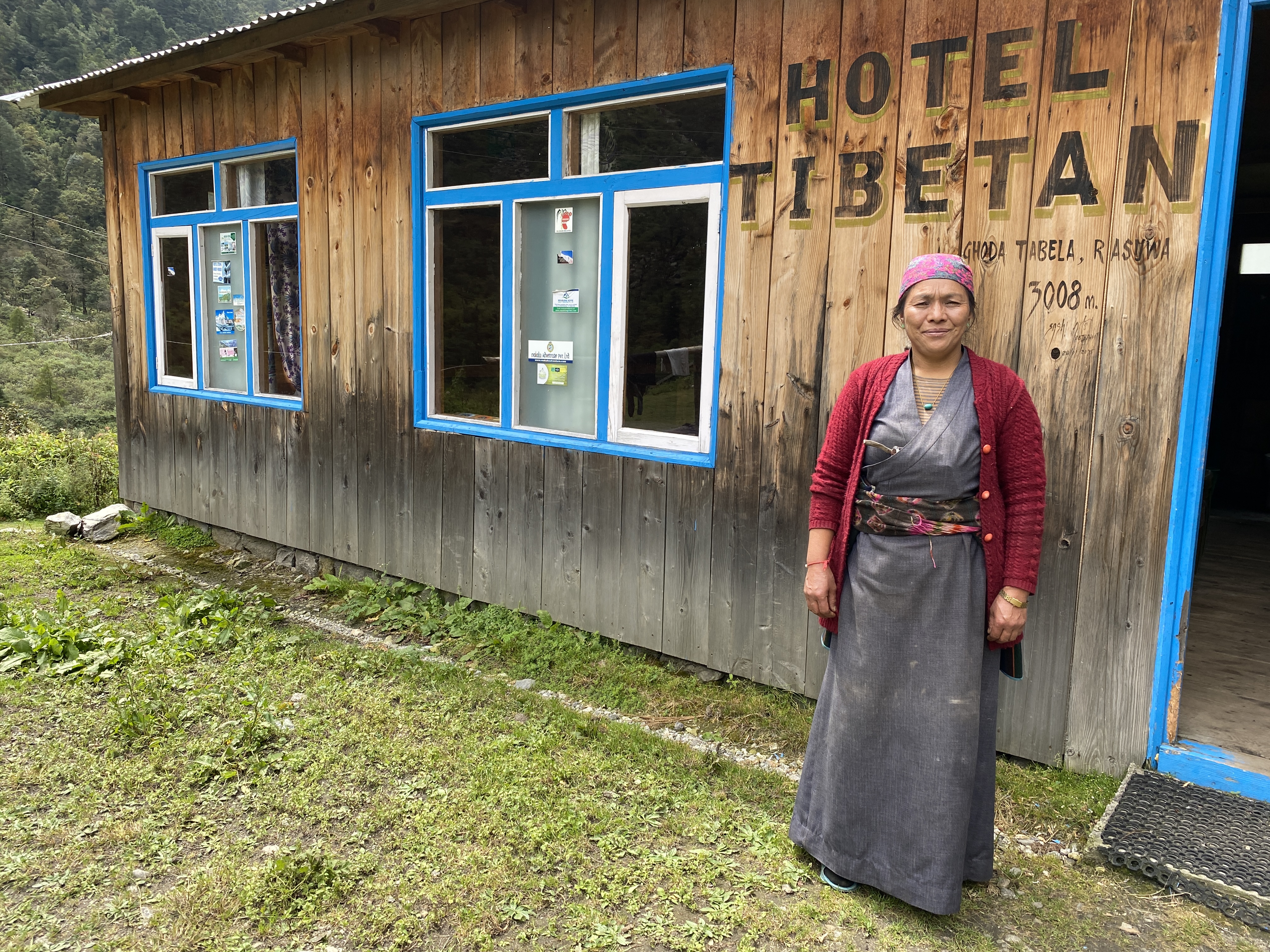
We can almost hear you thinking, "This is going to be a long day!" But, surprisingly, the descent often passes by quicker than expected. As you descend, your lungs grow stronger and the walk becomes progressively easier. After breakfast at the Higher Guest House, we'll bid a fond farewell to the wonderful team there and retrace our route back to Langtang Valley. We'll aim for a cozy morning tea stop at the bakery (about 1.5 hours into our journey), a perfect time for a little indulgence.
Then, it's off to Ghoda Tabela for lunch. A little tip: make sure to pre-order your lunch with your local guides. It's a popular spot around lunchtime, and we'd like to stay on schedule! Post-lunch, we'll re-enter the enchanting forest, making our way down to the Lama Hotel, where our trekking journey first began on our first night of the trek. We're planning to arrive back at the Lama Hotel by approximately 3.30-4 pm, rounding off another memorable day.
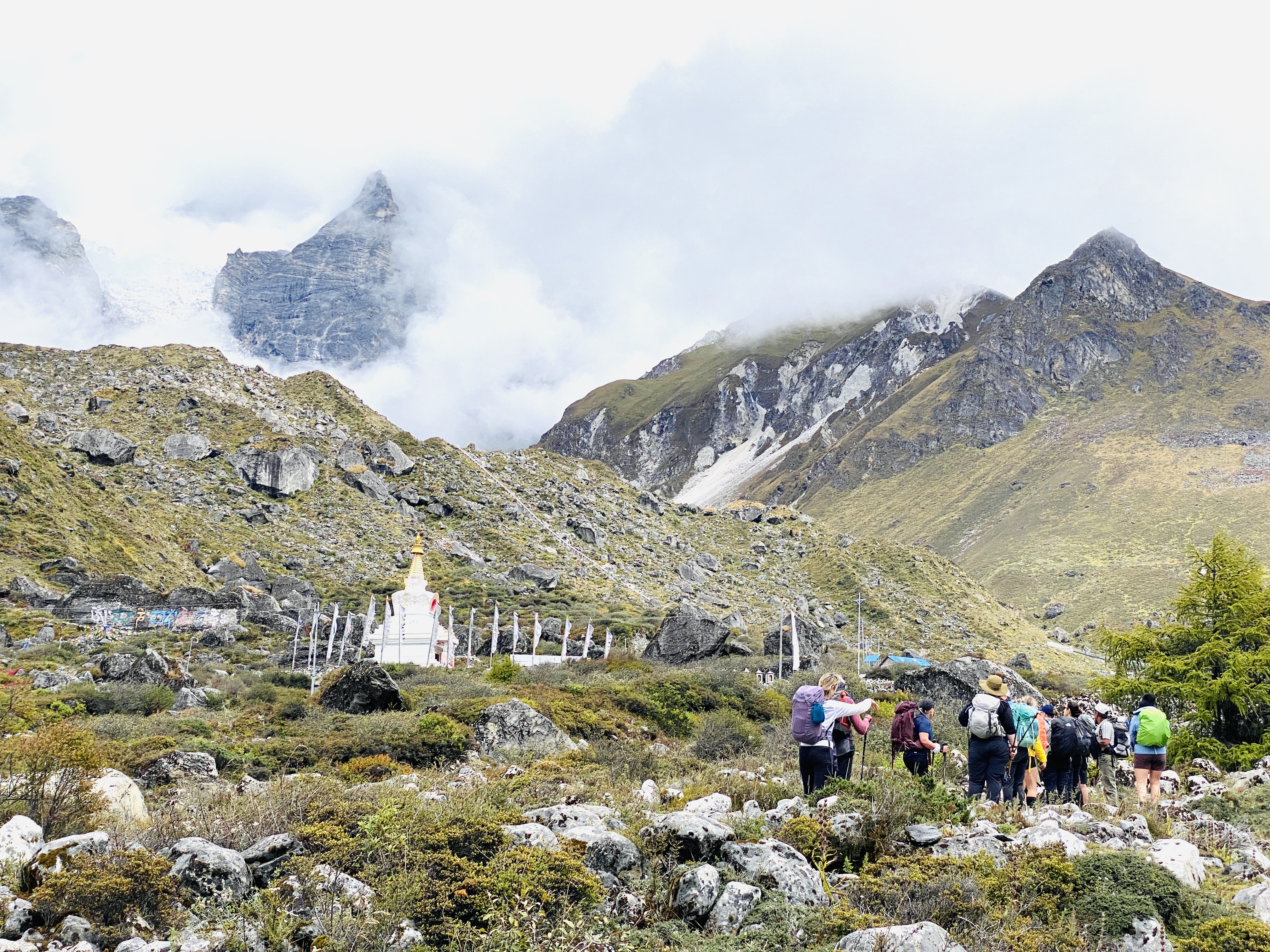
Today, our journey takes us down to Syabrubesi via Bamboo, meandering through the familiar rhododendron forest and alongside the Bhote Koshi river. With another eventful day ahead, we'll start early with breakfast at 7 am, aiming to set off by 7.45 am. For lunch, we'll stop at the village where we had our morning tea on the first day – feels like a lifetime ago, doesn't it? The 'didi' (sister) in the kitchen there is a culinary wizard, and we highly recommend trying the Mushroom Soup with Chapati or the Veggie Chow Mein, if time and orders permit.
Post-lunch, our descent continues down the valley until we reach the road, which offers relatively easier walking. We expect to arrive back in Syabrubesi Village between 3.30-4 pm.
Tonight marks your last night on the trek, and it's customary to show your appreciation with tips for your local guides and porters. Often, the porters may depart from the trip here or partway on the bus journey, so as a group, it's important to organize your tipping. We'll conclude our trek with heartfelt thank-yous and a celebratory night – expect dancing and cake, because you've truly earned it! Take this time to relax, have fun, and soak in every moment. Our advice? It all goes by too quickly, so enjoy every second!

After an early breakfast (the sooner we start, the better, considering the long bus ride ahead), we embark on our drive back to Kathmandu. A well-deserved hot shower and a refreshing beverage await you there. The journey typically takes between 7-9 hours, but as always in Nepal, it depends on a variety of factors – goats on the road, weather conditions, traffic, and so on.
Once we arrive at the Kathmandu Guest House, it's time to unpack your duffle bags and enjoy that long-awaited hot shower. Then, gather with our group for a farewell dinner and drinks around 6.15 pm at a reserved table in the Kathmandu Guest House restaurant.
A couple of notes for a smooth evening: Please bring your duffle bag to dinner to return it to your host, or leave it at reception for our team to collect. Also, keep your bag tag handy for when we get back to the Kathmandu Guest House. Having it ready will streamline the process, especially when you’re likely to be feeling a bit weary.
Today might be your last day in Nepal, unless you've personally decided to extend your adventure! Breakfast is included at the hotel, and we've arranged for airport drop-offs today. To ensure a smooth departure, please make sure you've given us your flight details so we can inform the hotel reception and your driver. Remember, it's essential to allow 3 hours from the hotel to the airport, factoring in traffic and time for customs – the roads can be unpredictable, and the airport may be bustling. Please don’t forget to tip your driver too!
A hot tip for a more comfortable wait at the airport: there’s a lounge you can access for about $35 AUD. It's a cozy upgrade from the general waiting area and well worth considering for some extra comfort.
Whether you’re departing Nepal today or continuing your travels, you’ll surely leave with a sense of accomplishment, camaraderie, and a treasure trove of memories from your journey to the roof of the world alongside like-minded, adventurous women.
It's crucial to understand the complexities that come with trekking in a developing country like Nepal. The grading, "Challenging," is assigned based on a multitude of factors, which include the terrain, trek duration, altitude, unpredictability of local conditions, and the sheer physical and mental demands of such an adventure.
Factors to Consider:
1. Terrain & Duration: The initial two days are particularly intense, comprising 8-9 hours of trekking each day and covering distances between 14-18km. This entails an elevation gain of over 1000m on the first and second day. On these days, the weather can be wildly unpredictable, ranging from rain, humid heat, to cold spells – sometimes experiencing all within the span of a single day.
2. Physical Preparedness: It's essential to approach this trek with robust fitness, flexibility, and a resilient mindset. While some days might feel moderate, the trek is significantly different from hiking experiences in countries like Australia.
3. Altitude: Altitude sickness can affect trekkers irrespective of their fitness levels. Although our groups maintain a slow, steady pace with frequent rest stops, this shouldn't be mistaken as an "easy pace." It's imperative that trekkers can keep up with the group and manage their personal daypacks, weighing between 6-10kg.
4. Trail Conditions: The trek begins on an open road, transitioning into a forested path with hundreds of steps. Expect to encounter mud and root steps, especially on the first day. The trail evens out by the second day afternoon. Certain sections, affected by previous landslides, consist of loose rocks and gravel, making hiking poles an indispensable accessory.

Preparation:
Training is non-negotiable. Incorporate stair training and extended day hikes in your regimen. For insights, please refer to feedback from women who've successfully completed this trek:
“My only advice to someone who is going to do this trek is to be kind to yourself on the first day. Your body is going to move slower than it would at home. Pace yourself; it is a mental game.”
“Make sure you know that even though you might be fit, the altitude can still make you feel unwell. 100% train for this trek. Even if the trek becomes easier than you expected, at least you feel fit and healthy. Hiking poles are a must as the first day is a big climb and getting to the higher peaks is steep!”.
“Come with an open mind and be flexible. The weather often changes, or you have a long bus journey, or there are no hot showers at the end of the day etc. You need to take Nepal in as it comes and not get too caught up on the small things. Appreciate it!".
Moderate:
- Trekking between 5-7 hours on uneven, rugged terrain.
- Expect steps and steep inclines. Adequate fitness is essential.
- Treks involve carrying a daypack. Trail conditions can vary from well-defined to rough.
Challenging:
- Trek between 7-9 hours on challenging terrains at higher altitudes (3500-5100m) with significant elevation gains.
- Treks are often in remote areas with unpredictable weather. Duration can sometimes extend due to adverse conditions.
- A daypack weighing between 6-10kg will be your constant companion.
Joining this trek requires a mix of physical readiness and an adaptive mindset, understanding that Nepal – with its unique challenges and rewards – offers an experience quite unlike any other. Embracing the unpredictable, respecting local customs, and "going with the flow" are not just suggestions, but prerequisites for a successful and enriching journey.

The majority of women embark on our adventures individually. Venturing to Nepal becomes even more empowering when shared with other like-minded women. In fact, on our recent Nepal treks, 8 out of 10 women took the plunge on their own. And guess what? Some of them even recognised familiar faces from previous adventures. How lovely! A week before you set off, we'll connect you into a WhatsApp group, making it easy for you all to touch base. Once you're at the hotel in Kathmandu, it's all about connecting. Whether it's sharing a meal, shopping, or exploring local wonders, you'll have your tribe right there with you.
Our Nepal treks will appeal to those wanting to push themselves a little further, you will need to be undertaking a regular exercise program 4-5 times per week and have a good level of fitness and health prior to attending. The trek is graded challenging for healthy clients in good physical condition. You can expect to spend up to 5-9 hours trekking each day on rocky marked and unmarked trails, with some steep inclines and declines. Treks involve carrying a daypack only.
We can’t underestimate how important it is to have a good-to-high level of fitness for the Nepal trek (and an open mind!). Training and preparation are an absolute must. Here are some key considerations regarding fitness and preparedness:
1. Duration & Terrain: The trek includes some days where you'll be walking for 8-9 hours, covering distances between 14-18km. Particularly in the initial two days, you'll experience an elevation gain of over 1000m. The terrain can be rugged and uneven, with portions that include steps, loose rocks, and gravel.
2. Physical Preparedness: While some days of the trek might be more moderate, it's crucial to be well-prepared physically. The experience is notably different from typical hiking trails, especially those in countries like Australia. A resilient mindset, combined with good fitness and flexibility, will serve you well.
3. Altitude: The trek takes place at higher altitudes, ranging between 3500-5100m. Even if the group pace is slow and steady, altitude sickness can affect trekkers. It's essential to be physically fit to adapt to the changing altitudes and conditions.
4. Training: Before embarking on the trek, it's advisable to undergo specific training, including stair training and extended day hikes. This will not only enhance your stamina but also prepare your body for the challenging terrains you'll encounter.
5. Carrying Gear: You'll need to manage your personal daypack, which can weigh between 6-10kg. Being fit will make this aspect of the trek more manageable.
The Langtang Valley Trek demands a combination of physical readiness, endurance, and adaptability. While it's challenging, the rewards in terms of experience and views are unparalleled. We recommend commencing a dedicated fitness regimen well in advance of the trek to ensure you're adequately prepared and can enjoy the journey to its fullest.
Some women may perceive Langtang as a more "moderate" hike, but overall factors such as traveling for hours on a bus, being in a developing country, the potential to hike in varied weather conditions, cultural differences, etc., combine to make it a challenging trip. You should be willing to be flexible in your approach, and having good fitness serves as a foundation for dealing with all of these aspects.
Fitness and Preparation – A regular fitness program that involves at least 3 to 4 sessions per week of aerobic activity, along with hill walking with a daypack and trekking on uneven surfaces.
Eating is a big part of travelling. You’ll experience the vast array of wonderful food available in the mountain tea houses. Expect a lot of tea – the name ‘tea house’ isn’t misleading! Often the first thing you’ll be greeted with at a tea house is a warm cup of black tea with sugar or ginger tea, great for altitude sickness. If you’re hiking in the rain, snow, or wind it’s the perfect way to relax.
Kitchen Insights: Expect meals to be prepared traditionally, often over a fire by the dedicated hosts. While it might take a bit longer than your usual cafe, remember you're here for an authentic experience, not a fast-food dash. Patience is key!
While much of the food is delicious, especially the Nepali staples like momos and dal bhat, the quality of the Western-style dishes will vary greatly. Kitchens are not like a Western-style restaurant, with chefs catering for a range of dietary requirements – what is on the menu is the menu. Please note, our treks do not cater for specific dietary needs, and it’s best to contact us to talk through any requirements prior to booking. Vegetarians and vegans are well catered for in Nepal.
Here’s a typical list of what you can expect to order in a tea house:
Breakfast
Lunch and dinner
Dessert (extra charge at own cost)
(rice pudding, chocolate pudding, apple or banana fritters)
Snacks (extra charge at own cost)
Help yourself to the generous portions of dal bhat, Nepal’s local dish that literally means “lentils and rice.” Mostly vegetarian, but sometimes served with meat on request, this dish is a daily staple across Nepal, India, and Bangladesh: a heavy lentil-based soup eaten with rice, curry, veggies and spices that locals will eat at least once a day. Seriously.
We highly advise you to stay away from the meat dishes as they might not be fresh and therefore not safe for consumption. According to the religious faiths of the Sherpa people, they are not allowed to slaughter in the mountains, so all the meat items are carried up to the tea houses on foot, often over many days! If the tea house is understaffed, or there is an abundance of trekkers, guides and porters will often hop in the kitchen to lend a hand. You are not expected to help, and are kindly advised not to.
Crisp glacial streams in the mountains aside, it won’t take you long to realise that the overall water quality in Nepal (particularly in Kathmandu) isn’t great and can make you very unwell. Using it to shower is totally fine (keep your mouth and eyes closed), but be warned that the water from the tap can be a funny colour and often smells… different. Tap water and river water in Nepal is unsafe to drink. You will have a choice between bottled water, purification tablets (please ensure you pack some) or using a Grayl water bottle.
Tip: When brushing your teeth, do not use tap water.
While the charm of the tea houses is undeniable, we advise against requesting them to boil water for your refillable bottles. Instead, arm yourself with a water filtration bottle. If you decide to sidestep this suggestion and ask for water anyway, be ready to cover the additional costs. Moreover, imagine the collective time it would take if everyone asked for boiling water—it's a bit like asking your barista for a complicated coffee order during the morning rush.
While it's possible to purchase water in plastic bottles from the tea houses, doing so amplifies our footprint on this beautiful environment. Bring some extra cash if you plan on this, but remember, every bottle counts.
Our top recommendation? Invest in a Grayl Water filtration bottle. To double up on safety, we typically filter our water and then add a purification tablet. It's an empowering step towards self-sufficiency on your adventure, while also championing a sustainable approach. Here's to staying hydrated without the hassle!
There’s nothing worse than trying to adventure when you have Nepal-belly (trust us, we’ve been there), so be safe and take extra precautions. Most trekking paths will have clean water tanks, but we recommend still investing in a water purification and filtration bottle — we use The Grayl GEOPRESS, which is hands-down the best travel-related investment we’ve ever made, and means we can drink the tap water anywhere we go – including India! Alternatively, bring along some water purification tablets or a SteriPen to drop into your bottle on the hiking trails just to be safe.
Drinking sufficient amounts of water in Nepal is essential to avoid the risk of dehydration and with prevention of altitude sickness, so if you follow the steps carefully, you should be safe for your trip. Please note, buying bottled water from villages is not included in your trip price. Please bring additional cash with you.
Note: We strongly recommend bringing electrolytes with you to keep hydrated throughout the days trekking, this almost needs to be essential to assist with altitude. We ask you to take these each day.
We recommend checking out the country specific information by checking out this website here. Please also read information for guidlines travelling to Nepal related to Covid 19 be clicking here. We also suggest you consult with your nurse/travel doctor.
Altitude sickness can affect anyone, regardless of age, trekking experience or level of fitness. It’s one of the top concerns people share about trekking Nepal and it’s a valid one. Unless you live at a very high altitude, our bodies are not acclimatised to the lack of oxygen in the high mountain air. Ascending too fast can cause problems. If symptoms of altitude sickness in Nepal (or anywhere else) are not addressed quickly, they can be extremely dangerous.
All our itineraries allow enough time for you to safely acclimatise. However, there are also things that you can do to support your own acclimatisation. If you know what symptoms to look out for, you can act quickly with the help of your trekking guide.
Altitude sickness, also called Acute Mountain Sickness (AMS), makes it difficult for oxygen to enter your body (vascular system) due to the low air pressure. The higher the altitude, the harder it is to get the amount of oxygen you need.
Altitude sickness can occur when you ascend to a high altitude too quickly. It’s more likely to affect people above 2,500m/8,200ft. Most of our treks climb to at least 4,000m/13,000ft, so there’s an element of risk.
We recommend that you take Diamox the day you arrive in Nepal (or approximately 2 days before your trek). Please also ensure you:
1. Stay hydrated.
2. Pack electrolytes with you to maintain your hydration.
3. Don't skip meals. Please ensure you are eating plenty of food (usually more than you are used to at home).
4. Walk slowly. This can sometimes feel a little challenging when you are accustomed to walking quickly at home. Please slow down.
We highly advise packing anti-nausea tablets and Propranolol with you. If you start to feel unwell, you must inform your guides as soon as possible.
Please download the Nepal Essentials Information PDF on this booking page for more information.
Women Want Adventure does not arrange flights to or from Kathmandu. However, we do arrange any necessary internal flights based on the trip you have booked. Please refer to your itinerary for additional information. If you are arriving on the first day of your trip departure, airport pick-ups are included, as well as airport drop-offs on the last day of the trip. We will require your flight information regardless of when you are arriving in Nepal to determine your arrival times.
Comprehensive Travel Insurance is a mandatory requirement for attendance on all our Nepal trips. The cost of medical, helicopter evacuation and/or hospital care can be very expensive. Your insurance policy should cover cancellation and curtailment, baggage loss or damage, emergency travel, repatriation, personal accident and evacuation from a remote area. It is your responsibility to ensure that you are fully insured before leaving home. Please send us your travel insurance number prior to departure.
Women Want Adventure is not liable for any cost or loss, directly or indirectly, from any personal disruption due to illness and COVID-19. Such costs or losses include but are not limited to: requirements to follow COVID-19 mandates, flights, accommodation, transfers, and other expenses incurred over and above the trip price. Once your trip has commenced there is no refund available for any portion due under any circumstances.
Please ensure that your travel insurance covers you for treks at high altitudes in Nepal, such as over 3000m. It's important to note that some insurance companies may not provide coverage for hikes over 3000m, so it's crucial to check the policy details carefully before purchasing.
You must provide evidence to Women Want Adventure that you have obtained the required personal travel insurance covering all of the activities you expect to participate in 70 days prior to trip departure.

There is a weight restriction on the items you provide to the porters of 10 kg per person. In Nepal, a porter will assist you throughout your trek by carrying additional items in a large duffle bag provided to you during the briefing. However, this does not mean you should pack whatever you can lay your hands on. The duffle bag is meant for storing the most essential things for the trek, such as additional clothing for evenings, spare shoes, hygiene products, a book, etc. Porters will carry up to 20-25 kg, which equates to approximately 10 kg per trekker.
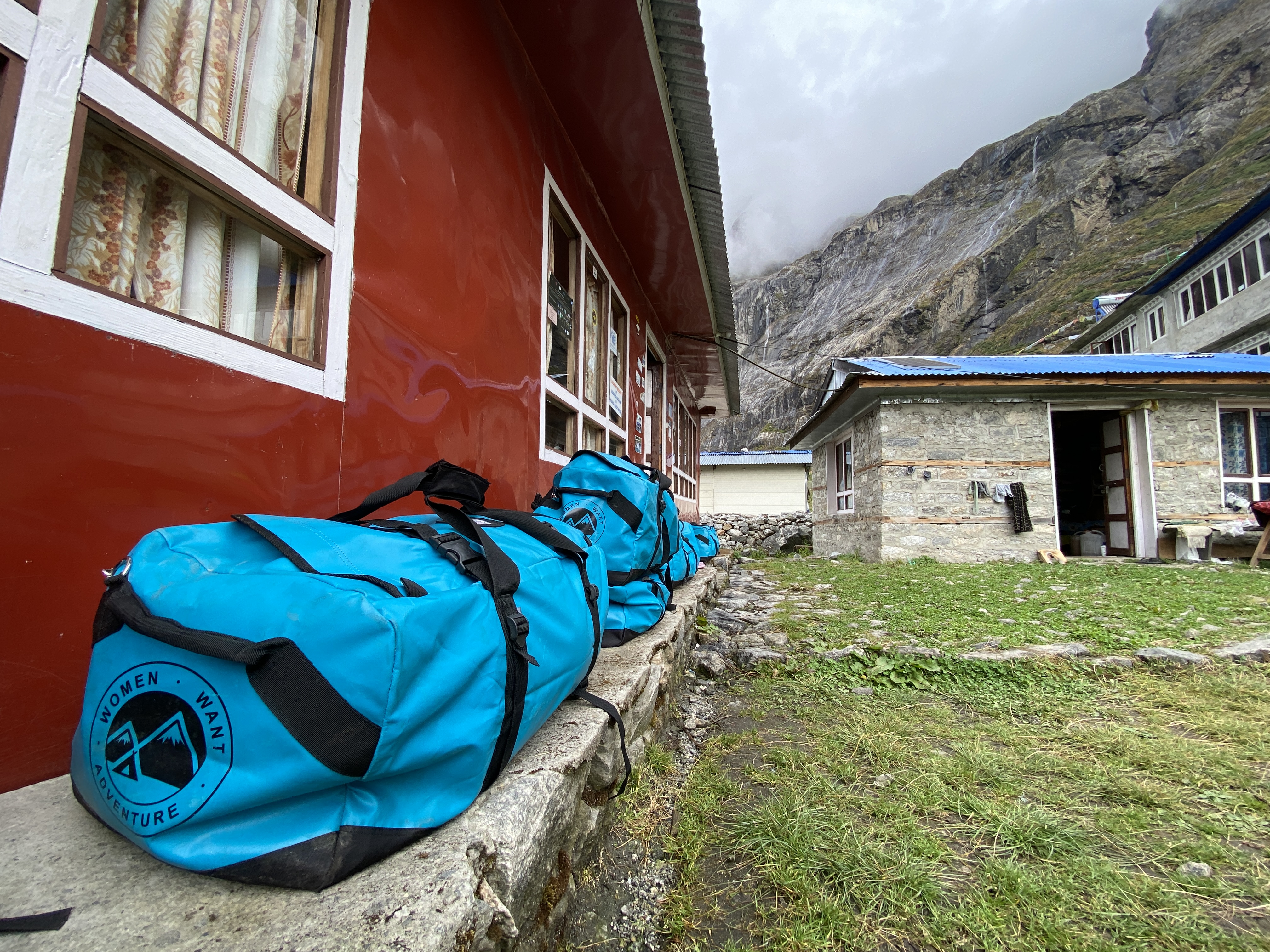
You will be sharing a duffle bag with another woman on the trip, and we cannot emphasize enough how helpful using packing cubes or dry bags can be. Why? Dry bags compress additional clothing and items efficiently, making it easier to locate your items in the shared duffle bag. We highly recommend purchasing a few dry bags and a compression sack for your sleeping bag. Please trust us when we say this will make a significant difference!
Out of respect for the hard work of the porters, it is important to prepare properly for trekking and reduce the number of items we take with us. It is best to pack as if we had to carry it ourselves – this way, it will be easier for us to determine what is essential and what is unnecessary. Trust us, the fewer non-essential items you have, the better.
For current advice, visit the Smart Traveller website here.
On arrival, the visa procedure is generally very quick and simple. You can expect some queues during peak tourist season, but if you wish to skip those queues, you can also consider getting a visa from the Nepalese Diplomatic Embassy in Australia prior to your arrival.
Please ensure that your passport is valid for 6 months after your return date from Nepal or you may be refused boarding your international flight to Nepal and restricted from gaining an entry visa. It is also important to bring 2-3 passport-size photographs with a light background which are often used for permits, SIM cards, flights etc. Visas can be obtained only through payment of cash in the following currencies: Euro, Swiss Franc, Pound Sterling, US dollar, Australian dollar, Canadian dollar, Chinese RMB, Hong-kong dollar, Singapore dollar and Japanese Yen.
You must pay in cash, and costs are AUD 40 for 15 days, AUD 60 for 30 days, and AUD 150 for 3 months. Credit cards, Indian currency or Nepalese currency are not accepted for visa fee payments.
To ensure a smooth arrival, please withdraw cash prior to arrival at the airport. If you wish to extend your stay, you can extend your visa at the Department of Immigration in Kathmandu and Pokhara offices for total of 120 days. Before arrival, you must complete the online application form by visiting online.nepalimmigration.gov.np/tourist-visa
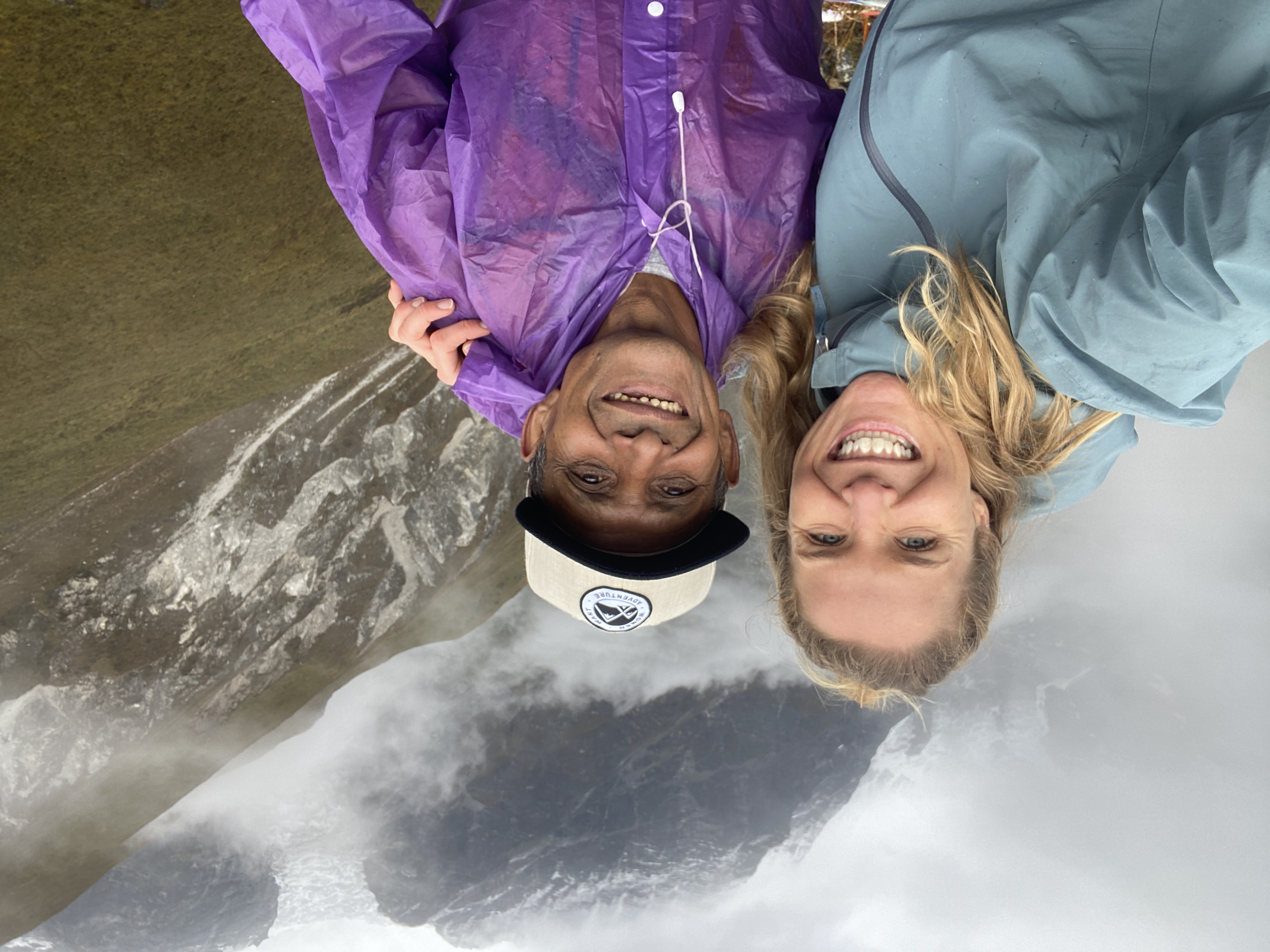
We work with some of the best local Nepalese guides in the industry, whom we personally met when preparing this trip. We learned about their villages, families, where their kids go to school, and the positive impacts guiding has on their village.
Every single one of them is government-licensed and highly experienced. Our treks are led by English-speaking local guides because exploring in the company of a local is one of the best ways to truly discover the culture, heritage, and everyday life of a new destination. In destinations with limited tourist infrastructure and remote villages, both of your guides will be there to assist you.

Sometimes your guides might have a soft-spoken manner. They have different guiding styles compared to our Women Want Adventure team. Please be patient and listen carefully. They are there to support you, brief you on what is coming up, and ensure you trek at a comfortable pace. If you're unsure about details such as breakfast times, departure times, or when your duffle bag should be ready for the porters, please don't hesitate to ask.
The average age of women attending our trips is 45 years. Ages can range from early 30's to mid 60s. All Women Want Adventure trips are for women over 18 years of age only.
It is customary in Nepal to tip drivers, guides, and porters. Although it may not be a familiar practice to you, it holds considerable significance for the people who will take care of you during your travels. Knowing how to appropriately tip in any country can be tricky, and tipping in Nepal is no exception. Please refer to your Nepal Essentials Guide information booklet, which can be downloaded on this booking page. Your confirmation emails will also outline a tipping guideline.
Upon arriving in Nepal, it's essential to withdraw cash from the ATM (there is one located inside the Kathmandu Guest House). You will need cash during the trek for tipping at local tea houses, as well as for the final night of the trek when local guide and porter tipping takes place. We recommend having an approximate figure of:
Tipping Guidelines for Langtang Valley Trek:
Please note that the tips are meant to be given as a total sum for the trip and not on a per-day basis. The following is an approximate breakdown in both AUD and Nepalese Rupees for minimum tipping estimates.
Additional Expenditures:
The aforementioned does not include smaller tips you might wish to give during tea house visits, money for purchasing gifts, buying bottled water, visiting a bakery along the way in Langtang Valley, etc.
Overall Recommendation:
Consider bringing 20,000 - 25,000 Rupees for the entire trek. Any unspent amounts can be used for additional tipping or for purchasing items for a porter (because you are lovely humans!), buying cold drinks at tea houses, enjoying entrees such as MoMos at tea houses, or shopping upon your return to Kathmandu.
Tip: When you withdraw money from the ATM, visit one of the many money exchange places and obtain a variety of smaller denominations, such as:
This will greatly assist you with your tipping. You might want to tip a chef at a tea house or the bus driver, and having a range of smaller denominations will make it easier. If you only have 1000 Rupees, it can be challenging to ask for change or make exchanges. This tip will enable you to tip in smaller amounts during your trek and be more convenient. Please try to follow this advice.
Our trek is perfectly timed for the September/October seasons, catching the tail end of the monsoon. While this brings a warm, humid climate, it's a transformative time for the trekking areas. September may offer a mix of cloudy skies and occasional rain, adding a mystic charm to the Himalayas. But as October rolls in, we're greeted with what many consider the best trekking weather: stable conditions, moderate temperatures, and clear skies that unveil the mountains in all their glory. This is the peak trekking season, so while we'll be sharing the trails with more fellow adventurers, it also adds to the vibrant atmosphere of the journey. Plus, you'll get to experience grand festivals like Dashain in October and Tihar in November, adding a cultural richness to your adventure.
Our departure dates are strategically set to be slightly earlier than the usual trekking rush, ensuring a more serene experience on the trails.
A quick reminder: The weather in Kathmandu, which is at a lower altitude, tends to be warm and humid, and quite different from the conditions we'll encounter on our Langtang Trek. So, pack accordingly and get ready for an adventure that offers the best of both worlds!
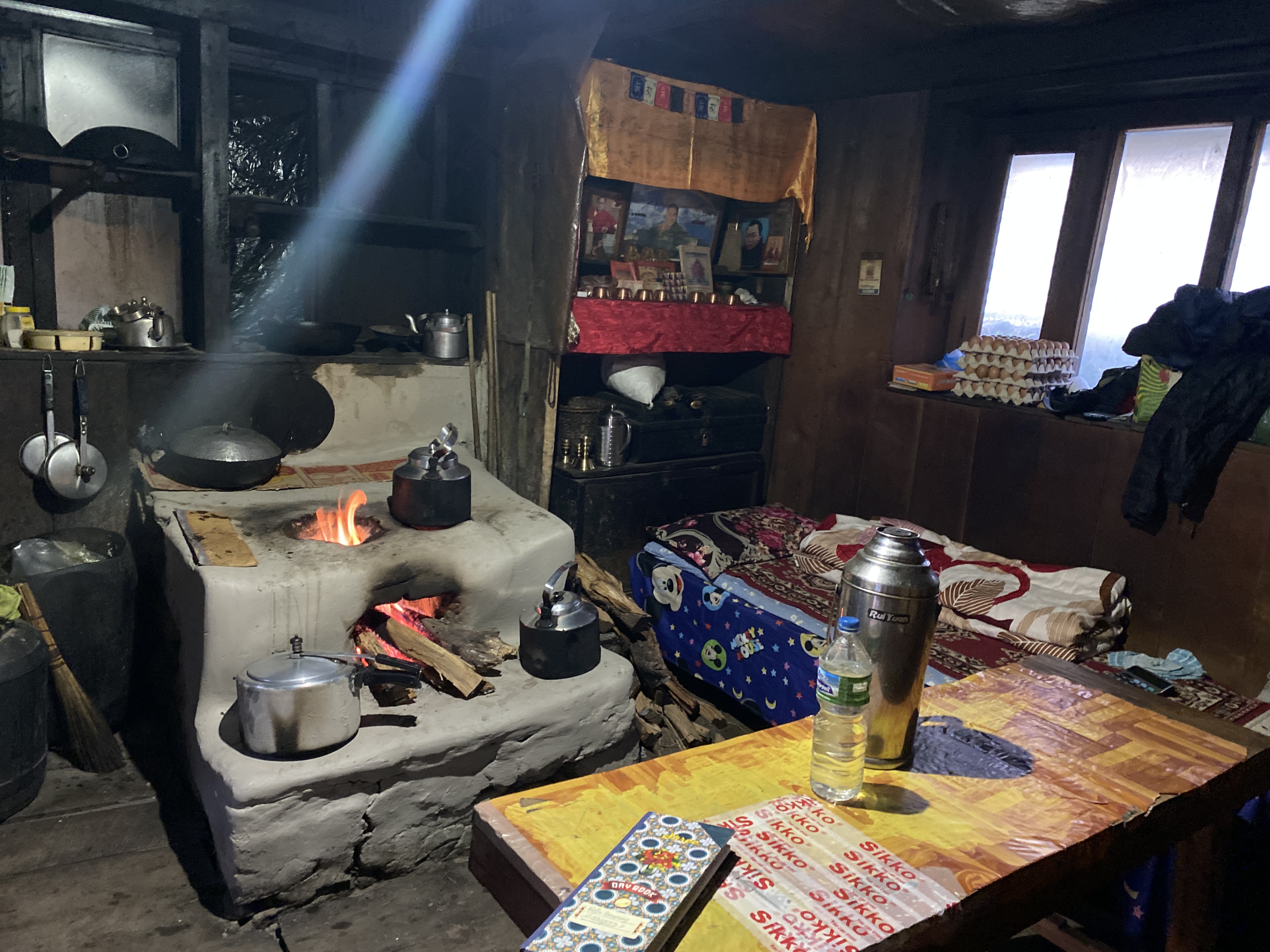
Nepal is a haven for vegans and vegetarians. In Kathmandu, you'll find an array of trendy cafes and restaurants serving creative twists on international favorites and Nepali cuisine. Throughout our trek, the tea houses we visit are well-accustomed to catering to vegan and vegetarian diets, as many of their dishes are plant-based or can be adapted to your preferences.
For those who are gluten intolerant or have celiac disease, it's crucial to inform us at the time or before booking. While we strive to accommodate dietary needs, it's important to note that the tea houses may not be able to completely eliminate the risk of gluten cross-contamination in their kitchens. We encourage you to take a look at the kitchens, keeping in mind that they may not always align with the highest standards of hygiene.
We also wish to emphasise that we cannot guarantee a nut-free or allergen-free environment on our treks. If you have severe or life-threatening allergies, we strongly advise consulting with your doctor and taking all necessary medical precautions. We ask that clients with allergies inform us on a medical form prior to departure and carry all required medications, including being capable of self-administration.
Tea houses differ from traditional restaurants, requiring patience and cooperation when ordering meals. Promptness for meal times is crucial, as it's culturally important and considered respectful in local customs.
Your trip package covers the majority of your expenses, including meals, permits, and accommodation. However, there are additional costs that you'll need to account for which are not included in the trip fee. These can include expenses for:
We advise allocating between 20,000 - 25,000 Rupee for these miscellaneous expenses.
Tipping Guidelines:
Please refer to our detailed tipping guidelines in the Essentials Guide for comprehensive information. When trekking, it's customary to tip at tea houses or even when using restrooms in the villages. Therefore, it's essential to have cash in smaller denominations handy. We recommend carrying between 10,000 to 12,000 Rupee in mixed denominations: 20R, 50R, 100R, 500R, and 1000R.
ATMs typically dispense larger notes like the 1000R, which can be challenging to use for tipping without expecting change. Once you arrive in Kathmandu, you can withdraw money from the ATM (there's one conveniently located in the hotel). Afterward, visit one of the numerous money exchange shops to break down larger notes into smaller denominations.
Please organise your tipping funds before you begin your trek and set it aside. Based on our experience, this preparation ensures you don't inadvertently spend your tipping money. It's crucial to have enough on hand for tipping your guides, sherpas, and porters on the final night of your trek at the tea house.
The total suggested withdrawal amount is approximately 30,000 Rupee, which equates to around $350AUD. Please factor this into your budget when planning your trek.
Note: Some women in the past have found themselves short on funds, especially if they've made numerous purchases or underestimated the tipping amount. If you're ever uncertain about tipping practices, your local guide is an excellent resource to consult.
Of course. Please carefully read our detailed terms and conditions policy here. Do not hesitate to contact us with any questions.
Tea houses offer a mix of Western-style sit-down toilets and traditional Nepali squat toilets. As we trek higher, the latter becomes more common. It's essential to bring enough toilet paper for the entire trek and always have hand sanitizer at hand. Carrying small tissue packets is also a good idea. For sanitary items, please use zip-lock bags for disposal in bins, as tissues and toilet paper cannot be flushed due to the lack of sewage systems in most villages. A small bin next to the toilet is usually provided for this purpose.
Regarding showers, they are typically available at Syabrubesi, Lama Hotel, Langtang Valley, and Kyanjin Gompa, although hot water can be hit or miss, especially at Lama Hotel and higher altitudes. Be prepared for the possibility of not having a hot shower on some nights. Packing wet wipes can be a handy alternative.
End to end explanation of every point was brilliant.
My experience with dealing with WWA has been amazing. So helpful with any questions I had about coming on the Langtang Trip. I booked this trip on my own and it was out of my comfort zone for sure! Monique and the team provided all the trips I needed and helping with the little things from my arrival in Nepal to departure. I loved the food, the view of the peaks and the brownie slice in Langtang Valley! Note to other women would be come with an open mind and be flexibly with your mindset!
If hiking in Nepal has been on your bucket list, you should give it a crack!
The Langtang Valley trip was fantastic!!!
As has been my usual experience with WWA, the Langtang Valley trip was fantastic. The support staff, organisation, care and safety provisions were all excellent. I am always confident that Monique and the WWA team have been thorough in developing any tour and plans A, B and C should any little problems arise, and this was demonstrated again with this trek. I always feel I am in safe hands with WWA. Also, really inspiring and supportive women sign up for these adventures to create wonderful shared memories.
© Copyright 2024 Women Want Adventure. All rights reserved.
Made with by SiteSuite in Sydney